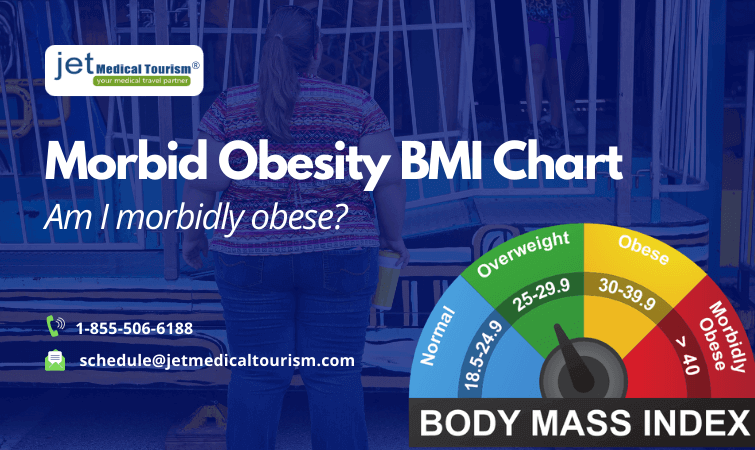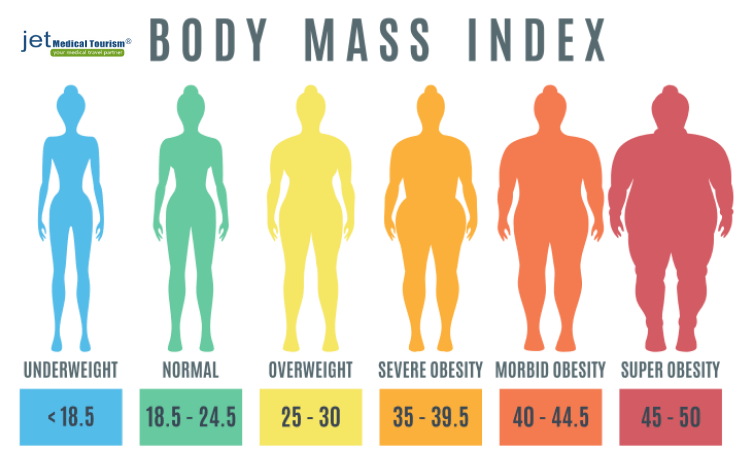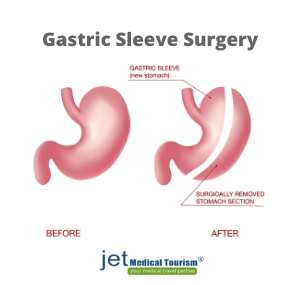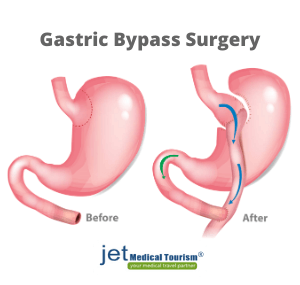Morbid obesity BMI chart: Am I morbidly obese?

Morbid obesity BMI is a critical indicator to determine if you are suffering from a severely high level of obesity. As an individual who is excessively overweight, you might wonder, “Am I morbidly obese?” Only a qualified metabolic and bariatric expert can answer this question with certainty and recommend an appropriate medical solution. Medical researchers over the decades have defined various classes of obesity, and different clinical approaches are available to treat morbid obesity.
BMI calculator for men and BMI calculator women are well-established tools that can help determine your exact level of obesity. During your initial consultation with an obesity medicine specialist or bariatric surgeon, you should ask, “Am I overweight?” Your medical provider will explain you the difference between overweight vs. obese, and will evaluate multiple parameters to confirm your precise diagnosis. The good news is that obesity is fully treatable with bariatric surgery.
Are you worried about your morbid obesity BMI? Our top team of bariatric surgeons at Jet Medical Tourism® is here to help. Call us today to schedule a free consultation!
What is morbid obesity?
Morbid obesity is a medical condition where the patient’s body mass index (BMI) is 40 or higher. Most patients in this condition will show morbid obesity symptoms, such as shortness of breath after physical activity, joint pains, and problems related to digestion. When you consult with a weight loss surgeon, you should ask them to explain the exact morbid obesity definition and share the morbidly obese chart with you.
Morbid Obesity and Related Illnesses
In some cases, you may not be super morbidly obese, and your BMI may be under 40. But if your BMI is 35 or higher and you suffer from obesity-related diseases such as type 2 diabetes, sleep apnea or hypertension, you may still be diagnosed with morbid obesity. Therefore, what is considered morbidly obese will not only depend on your BMI, but also your co-morbidities, if any.
Higher Risk of Serious Diseases
When you talk to a specialist about what does morbidly obese mean, they will also discuss with you the potential health risks you face in this condition. What BMI is morbidly obese or what weight is obese can sometimes vary depending on your health risk profile. People who suffer from this condition are usually at a higher risk of diabetes, heart disease, acid reflux disease, fatty liver disease, and even cancer.
What is considered morbidly obese
If you believe that you have been putting on excessive body weight, it is time to ask yourself: “Am I morbidly obese?” When you face this question boldly, it will give you the courage to take actionable steps to reverse this condition. What is considered morbidly obese is a function of multiple parameters. A qualified surgeon will evaluate all the parameters accurately to make a confirmed diagnosis.

Am I Morbidly Obese?
According to the established medical norms, you may be suffering from morbid obesity and may be a candidate for bariatric surgery, if:
- You have morbid obesity BMI (i.e., BMI of 40 or above)
- You have a BMI between 35 to 40, but suffer from obesity-related co-morbidities
- You are at least 100 pounds in excess of your ideal body weight
- You have failed to achieve the required weight loss despite undergoing a diet and exercise program
- You fit the morbid obesity definition as determined by your surgeon, even if you are technically below the morbid obesity BMI
RELATED READ: Gastric sleeve requirements: Do I qualify for it?
Fat Deposits and Waist Circumference
It is important to understand the distinctions between overweight vs. obese and morbidly obese. In clinical terms, you are overweight if your BMI is 25 or above, and obese if your BMI is 30 or above. But surgeons will also screen you for the extent of your fatty tissue deposits and waist circumference. Excess fat pockets around your waist instead of hips increase your risks of heart disease. Risks increase with a female waist size of 35 inches or above and male waist side of 40 inches or above.
Morbid obesity symptoms
Morbid obesity BMI chart is a tool to clinically identify the classes of obesity. Clearly, if you have excessive body weight in proportion to your height, it will be visible to you and others. It is best to consult with an experienced weight loss surgeon if the BMI calculator women or the BMI calculator for men indicates obesity. But apart from this quantifiable measure, you should also watch out for other morbid obesity symptoms.
- Shortness of Breath: You may experience breathlessness even if you perform a short walk, lift a heavy object, or do another type of normal physical activity.
- Profuse Sweating: If you are suffering from morbid obesity, your sweat glands may be overactive and your body may generate more heat. As a result, you may have excessive sweating.
- Snoring during Sleep: If you snore at night and have sleep apnea, it is time to ask: “Am I morbidly obese?” This could be one of the key symptoms to signify your condition.
- Fatigue and Tiredness: You may feel tired quickly even after a minor physical activity or exercise. Some morbidly obese patients also suffer from fatigue and loss of energy.
- Joint and Back Pain: Osteoarthritis in the joints is commonly seen in patients who have morbid obesity. Nagging back pain may also occur because the spine is carrying excessive weight.
YOU MIGHT WANT TO READ: BMI For Gastric Sleeve Surgery
Morbid obesity BMI
The body mass index of a healthy person will range between 17 and 25. Morbid obesity BMI is 40 or above, which is also called severe obesity. If you suffer from co-morbidities, you may be considered morbidly obese even with a BMI of 35 or above. At the time of your consultation with a bariatric and metabolic surgeon, you should clearly ask what does morbidly obese mean, and whether you fall in that category.
Morbid Obesity BMI Chart
Here is a generally accepted morbidly obese chart, which will indicate whether you are having this condition and may require bariatric surgery.
| Body Mass Index (BMI) | Class of Obesity |
| 30 to 34.9 | Mild |
| 35 to 39.9 | Moderate/Morbid |
| 40 to 44.9 | Severe/Morbid |
| 45 to 49.9 | Super Morbid |
| 50 and above | Super-Super Morbid |

Examples of Morbid Obesity
- Morbid Obesity BMI Calculator for Women: A woman with a height of 5’ 4” and weight of 235 lbs will have a BMI of 40.3. This would place her in the category of severe morbid obesity (Class III obesity).
- Morbid Obesity BMI Calculator for Men: A man with a height of 6” 2” and weight of 315 lbs will have a BMI of 40.4. In other words, he would have a nearly identical morbid obesity as the woman in the above example.
Super morbidly obese chart
If your BMI is 45 or above, but less than 50, you may be suffering from super morbid obesity, according to the standard classes of obesity. If your BMI is 50 or higher, you may be suffering from super-super morbid obesity. If the morbidly obese chart indicates these levels of extreme obesity, you should seek medical advice as soon as possible and start preparing yourself for a possible bariatric surgery.
Health Risks of Super Obesity
People whose morbid obesity BMI classifies them as super or super-super obese, they will have a significantly higher mortality risk compared to the normal population. These patients are also at a higher risk of extreme obesity linked conditions, such as diabetes, GERD, cardiovascular disease, infertility, dyspnea, obstructive sleep apnea, poor urinary control, venous disorders, depression, high blood pressure, osteoarthritis, and cancer.
Is Super Obesity Treatable?
When you ask your surgeon, “Am I morbidly obese or super morbidly obese,” they will determine your exact diagnosis and reassure you about treatability. Advanced bariatric surgery procedures are now used to treat super morbidly obese patients. Success rates are high, and you can expect to lose at least 50 percent of your excess body weight within the first one to two years. Your co-morbidities are also likely to resolve with this surgery.
Obese vs. morbidly obese
It is important to differentiate between obese vs. morbidly obese so that the appropriate treatment can be recommended. The CDC has provided a free online BMI calculator, which can help you determine your body mass index. Once you know your BMI, you can request your physician or surgeon to provide you a morbid obesity BMI chart. With this chart, you will know what BMI is considered morbidly obese.
Example: Obesity vs. Morbid Obesity
If your height is 5 feet 9 inches, and your body weight is 203 pounds, your BMI as per the CDC calculator will be 30. This indicates that you suffer from Class I obesity. On the other hand, with the same height, if your body weight is 271 pounds, your BMI will be 40. This indicates that you suffer from Class III obesity or morbid obesity. Even with a BMI of 35, you may fit the morbid obesity definition, if you have related medical conditions.
Treatment: Obese vs. Morbidly Obese
If the body mass index chart for women or men shows that you suffer from Class I obesity, a bariatric specialist may recommend non-surgical solutions for weight loss. A medically supervised diet and fitness plan may be the ideal option in your case. However, in case of morbid obesity, a bariatric surgery may be your best treatment option. The treatment approach is the key difference between obese vs. morbidly obese conditions.
How to start losing weight when you are morbidly obese
Once the critical questions, such as “Am I overweight or am I morbidly obese,” have been answered, it is time for concrete action to restore your health. For the morbidly obese, weight loss without surgery is difficult but not impossible. A dedicated bariatric surgeon will first recommend you to reduce your morbid obesity BMI through a supervised diet and exercise program. If it fails to work, you may have to undergo weight loss surgery.
- Seek Medical Advice: If you want to know how to start losing weight when you are morbidly obese, your first step should be to seek professional help. Under supervision from a bariatric surgeon, you can proceed with a weight loss plan.
- Join a Support Group: Your weight loss journey will get easier when you have companions who are going through the same experience as you. Consider joining an offline or online support group exclusively for patients with morbid obesity.
- Increase Physical Activity: Although you may not straightaway hit the gym or join a tennis club, but you can make a small start by going for short walks and performing mild activities at home. Morbid obesity treatment will get easier when you improve your fitness level.
- Consider Weight Training: If you are committed to morbidly obese weight loss success, you should consider weight training exercises. Some of these exercises can be performed sitting down. These will help burn calories and build your muscular resilience.
- Pursue Healthy Hobbies: If you remain idle for long hours, you will have a tendency to eat and snack just to kill boredom. The best way to take your attention away from frequent hunger is to develop one or more hobbies and pursue them with passion.
- Enlist Friend and Family Support: Many people who are diagnosed with morbid obesity BMI tend to isolate themselves or struggle with stress and depression. To win your battle, reach out to your friends and family for emotional and psychological support.
- Follow a Wholesome Lifestyle: If you have a habit of smoking or drinking, seek professional advice to curb them as far as possible. Sleep on time, get up early and follow a moderate, healthy lifestyle. This will prepare your mind and body for morbid obesity treatment.
- Go for Bariatric Surgery: If you are wondering about how to start losing weight when you are morbidly obese, you should know your options. Bariatric surgery is a safe and proven solution that can help you achieve permanent freedom from morbid obesity.
Morbid obesity treatment
Morbid obesity treatment involves a comprehensive approach, which usually includes bariatric surgery. If you are worried about what does morbidly obese mean for your health and whether you are a candidate for your surgery, you should talk to a weight loss surgeon. These experts are trained to treat morbid obesity and will provide effective solutions, support, and treatment plan to help you eliminate obesity. A typical morbid obesity treatment plan will include the following elements.
- Changes to Diet: Based on your diagnosis and medical evidence, your surgeon will recommend a dietary modification plan under the supervision of a nutritionist.
- Exercise and Fitness: Depending on your physical condition and abilities, your surgeon will devise a controlled exercise and fitness regimen under a fitness expert’s guidance.
- Behavioral Modification: If you smoke or drink or have other lifestyle habits that require modification, your surgeon or a professional counselor will help you modify or overcome them.
- Bariatric Surgery: Your surgeon will recommend the most appropriate weight loss surgery and create a customized plan, depending on your morbid obesity BMI chart.
- Post-op Diet Plan: This is the most important part of your morbid obesity treatment following the surgery. Commitment to the prescribed plan will help you achieve your weight loss goals.
Weight loss surgery options for morbidly obese woman and man
Based on your morbid obesity BMI chart and various other factors, your bariatric surgeon will advise you the appropriate surgery options. Feel free to discuss your concerns during your initial consultation with the surgeon. Seek clarity on questions, such as: “Am I morbidly obese or am I overweight,” and review the pros and cons of different surgical options applicable to your case.
YOU MIGHT WANT TO READ: Gastric sleeve weight loss chart, timeline
 Gastric Sleeve Surgery
Gastric Sleeve Surgery
For a moderate to severe level of morbid obesity, gastric sleeve surgery may be the first choice of your bariatric surgeon. This is a less invasive and highly effective surgery to help achieve weight loss. It is, by far, the most popular surgical option today worldwide for millions of patients struggling with morbid obesity.
The vertical sleeve gastrectomy (VSG) procedure involves surgical removal of about 80 percent of your stomach volume. It will leave behind a small, sleeve-shaped pouch, which will be sealed with staples. Gastric sleeve will reduce your capacity to eat at one time, and will also curb your appetite. You can expect dramatic weight loss results within a year.
RELATED READ: Gastric sleeve vs gastric bypass
 Gastric Bypass Surgery
Gastric Bypass Surgery
If you are diagnosed as super morbidly obese or you have co-morbidities such as type 2 diabetes, your surgeon may sometimes recommend gastric bypass surgery. Clinically known as Roux-en-Y gastric bypass, this surgery is relatively more invasive and is performed in two stages. The first stage is similar to sleeve surgery, where the surgeon will create a small stomach pouch.
In the second stage of this procedure, your surgeon will reroute your small intestine by attaching the lower portion of it directly to the newly created stomach pouch. This will diminish calorie absorption, apart from reducing your capacity to eat and store food. You can expect more rapid weight loss with gastric bypass surgery.
 Duodenal Switch Surgery
Duodenal Switch Surgery
Duodenal switch surgery is more invasive and more complex procedure compared to the other techniques. Your bariatric surgeon may recommend this surgery if you are suffering from super-super morbid obesity levels (with a BMI of 50 or above.) This procedure essentially combines two separate surgeries that are performed at the same time.
Stomach volume reduction is performed in a duodenal switch surgery, similar to the sleeve gastrectomy procedure. In addition, this procedure also involves re-attaching of the duodenum, which is the first section of the small intestine, directly with the last section. Maximum weight loss can be achieved with this procedure, but because of its complexity, it may only be performed if you are suffering from Class 5 morbid obesity.
CHECK THIS TOO: Gastric bypass vs duodenal Switch
I am morbidly obese and need help
Some patients try to avoid or wish away their problem of obesity, which can only worsen their condition. It is important to be realistic and ask your doctor: “Am I morbidly obese?” If the answer is ‘yes’, there is no harm in accepting the fact that, “I am morbidly obese and need help.” Once you have crossed these psychological barriers, you are ready to seek treatment.
Obesity is Not Your Fault
To begin with, you should know that morbid obesity is chronic disease that is not self-inflicted. Do not go on a guilt trip, and do not feel discouraged if you have failed to lose weight through diet or exercise. Accept support from your family and friends who are compassionate and willing to help. Meet a mental health counselor, if necessary, to recover your self-confidence.
Find a Caring Doctor
An obesity medicine specialist or bariatric surgeon can play the most vital role in helping you get ready for morbid obesity treatment. You need to have the most skilled and caring surgeon on your side, whom you can trust and bond with. With their encouragement and medical advice, you will be ready to win the battle against obesity.
RELATED READ: Finding gastric sleeve surgeons: A step by step guide
Commit to a Surgery
Based on your morbid obesity BMI, if your surgeon recommends bariatric surgery, get committed to it – there’s no other way to put it. Schedule a convenient date of surgery and diligently follow your surgeon’s pre-operative guidelines. Your journey, which began from a courageous call of “I am morbidly obese and need help,” will likely culminate with outstanding weight loss results.
READ THIS TOO: Do I qualify for weight loss surgery?
Contact Jet Medical Tourism® to see if you qualify for bariatric surgery
Are you caught in the confusion of overweight vs. obese vs. morbidly obese? Do you need clear and direct answers to all your questions related to morbid obesity BMI? Jet Medical Tourism® surgeons is the go-to place where you will receive the right answers and solutions to your problem of obesity.
Our top-rated and compassionate bariatric surgeons have been helping a vast number of patients get rid of morbid obesity and reclaim their health. We are here to help you go through your weight loss journey in a safe, successful, and affordable manner. To learn more, give us a call today!




